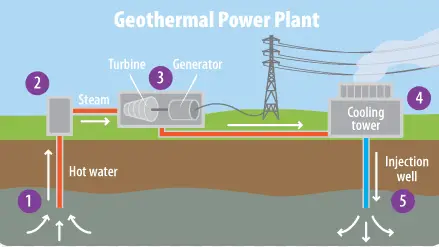Geothermal Energy Definition
Contents
show
The energy which is generated by the temperature of the Earth and also gets stored inside the Earth is known as the geothermal energy.
In the inner core of the earth, there is a layer of hot and molten rock called ‘magma’ which has temperature as high as 4,000°C. The sources of this heat energy are magnetic or radioactive decay processes occur within the interior of the Earth. Geothermal energy is present in plenty of amount for human needs but as this is stored inside the Earth so taking it out is a very expensive process.
Hence a little of it which comes out itself from the hot springs and melting the rocks are used by humans.

- In a geothermal power plant, water to be seeping into the underground over time gains heat energy from the geothermal reservoirs. This water is heated and then sent through a steam turbine where the thermal energy (heat) is converted into electricity through, a generator. The next step in the cycle is cooling the fluid and sending it back to the heat source.
- The injection wells ensure that the water that is drawn up is to be returned to the geothermal reservoir where it regains the thermal energy and this cycle continues.
Geothermal Energy Pros and Cons
Advantages of Geothermal Energy
- Geothermal energy is the most versatile and least polluting renewable energy source.
- The power generation levels are higher for direct uses such as space heating, geothermal heat pumps, hot water bath stores, aquaculture, greenhouses, industrial processes and enhanced oil recovery systems.
- It delivers a greater amount of net energy than other conventional or non-conventional energy sources.
- Within the electric supply system, geothermal sources could provide steady baseload power with very low variable costs.
- Geothermal energy is relatively inexpensive.
Disadvantages of Geothermal Energy
- The overall efficiency of power production is low which is about 15% compared to fossil fuel plants.
- The withdrawal of large amounts of heat may result in surface subsidence.
- The steam and hot water gushing out of the earth may contain H2S, CO2, NH3 and radon gas, etc. If these gases are vented out, the air pollution will be a real hazard. These gases are to be removed by chemical action before they are discharged.
- The drilling operation is noisy.
- Large areas are needed for extraction of geothermal energy.
